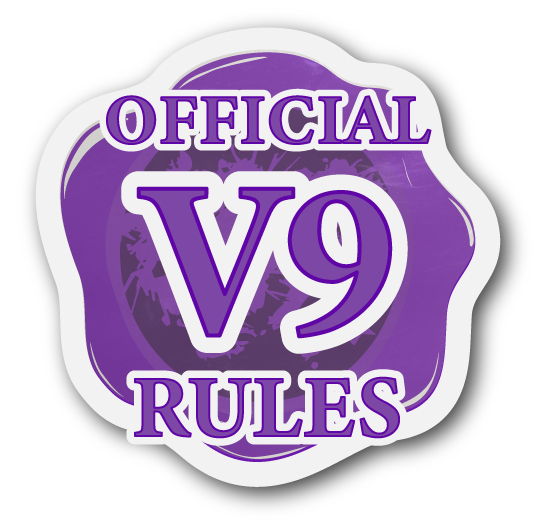Difference between revisions of "V9: Additional Rules For Strikes"
(fixing template transclusion errors) |
m |
||
| Line 2: | Line 2: | ||
<onlyinclude>====Additional Rules for Strikes==== | <onlyinclude>====Additional Rules for Strikes==== | ||
{{:V9: Shot in Motion}} | {{:V9: Shot in Motion}} | ||
| − | |||
| − | |||
| − | |||
{{:V9: Multiple Points of Contact}} | {{:V9: Multiple Points of Contact}} | ||
{{:V9: Friendly Fire}} | {{:V9: Friendly Fire}} | ||
{{:V9: Combat Etiquette}}</onlyinclude>{{V9 Additional Rules For Strikes}} | {{:V9: Combat Etiquette}}</onlyinclude>{{V9 Additional Rules For Strikes}} | ||
Revision as of 06:49, 18 January 2023
- The Amtwiki is the official home and primary source for Amtgard V9 Rules as of February 25, 2023.
- These rules are currently in Open Alpha Playtest. See the Playtest Disclaimer for more details.
- To learn more about Amtgard V9 Development, please visit Amtgard.com.
- To view the current Amtgard V8 ruleset, please see the Amtgard V8 Rulebook.
Contents
Additional Rules for Strikes
Shot In Motion
If a player is wounded, killed, or otherwise prevented from attacking while they are in the middle of completing a striking motion, the attack is not interrupted and the motion can be completed before they suffer the negative effect. This should be a clear case of finishing an already-started attack, meaning that it requires no change of direction and the last motion required to finish the strike has already been started prior to being affected.
- Melee strikes must land within a half-second of the user being affected.
- Projectiles must be airborne within a half-second of the user being affected.
- Shot in Motion only applies if the attacker is affected. It does not apply if the defender becomes immune prior to contact, such as via an ability like Shadow Step.
Multiple Points of Contact
If an attack makes contact with multiple unique Hit Locations at the same time, it will inflict a strike against each Hit Location where contact met the requirements for a valid strike. Contact on the line between locations are affected as per Torso Priority. A single weapon cannot strike the same Hit Location more than once per attack, regardless of how many individual points of contact it makes.
Friendly Fire
All strikes initiated with intent to affect a player will affect whomever they hit, regardless of the intended target. The only exception is that a player can never harm themselves with their own melee weapons unless they actually wish to do so.
Any contact that was not intended to be a strike may always be ignored if both parties agree.
- An Archer missing their target and accidentally striking an ally in the back.
- An Assassin sneaking up and backstabbing someone who they believed was an enemy but turns out to be an ally.
- A Barbarian's rock bouncing off an enemy's shield and rolling back to hit themselves.
- A Monk unknowingly striking an ally with the other end of their quarterstaff while making an attack.
Examples of strikes that can be ignored:
- A Warrior tapping an ally with their sword to get their attention.
- A Paladin resting their spear over their shoulder and accidentally hitting someone as they turn around.
- An Scout accidentally dropping their tomahawk onto their own leg.
- An Anti-Paladin with a double-ended weapon accidentally striking an ally behind them while pulling back from a big thrust.
Battlefield Etiquette
Everyone processes the game differently so it is important to communicate early and often with your opponents. Keep the Honor System in mind as you work with your opponent to execute the game rules as best as you can.
- If you have to think about it, take it. If you are unsure whether an opponent’s strike or ability against you was valid, give them the benefit of the doubt and take it. Only attacks which are clearly invalid should be treated as such, and in those cases it is common courtesy to announce to your opponent the reason you believe it to be so.
- It is the responsibility of the victim of an attack to determine the location of strikes against them. If the victim is unsure or didn't realize they were struck, the attacker may clarify and call out what they believe happened. If the attacker is unavailable, such as in the case of a run-by or long-range projectile, then the victim should take whatever they believe is most likely to have occurred.
- As long as you and your opponent(s) agree on the outcome, the exact details of any encounter are moot. It's okay to be slightly inaccurate if the alternative is wasting time in the middle of battle trying to sort out fine details.
- Do not call the results of other engagements unless the players involved are asking for your opinion.
- If you notice a player is repeatedly ignoring strikes or effects that you believe are connecting, ask them about it politely in the form of a question ("Did that connect?" "Where did that land?" "Was that hand or arm?"). If the behavior continues, bring the issue to the attention of a Reeve and they will seek to resolve it. Do not confront the player directly again after this point, even if you believe you have a good rapport with them. Allegations of misconduct are often better received when filtered through the proper channels and handled with care.
